Southern Thailand

Casamara
John & Susan Simpson
Sun 9 Feb 2025 06:54
‘How many massages do you have a week: 1, 2, 3, 4, 5?’ This was the first question on the form I had to complete at the Spa in our hotel in Bangkok. My lovely masseuse looked shocked when I confessed I don’t usually have any massages a week. In fact I couldn’t even remember when I’d last had one! However, when you see the number of massage parlours lining the streets of Bangkok you can only conclude that there really are people who have 5 massages a week. Massage is a big thing here, and I don’t mean the dodgy ones, of which there are also plenty on offer! I soon got into the massage culture, though, and did my bit for the Thai economy. A foot massage after a long day’s sight-seeing is a very good thing. Good job they wash your feet first! We spent the first part of our SE Asia land travel adventure between Bangkok and Pattaya, about 100 miles to the south. About 11 million people live in Bangkok and it's a big high-rise city living at a frantic pace. As we flew into Bangkok we could see a haze of smog hanging over the city and that persisted throughout our time there. We thought it might lift as we left the city to go down to Pattaya but it was the same there too, and for the distance in between. Industrial emissions and vehicle fumes combined with smoke from crop burning put Bangkok in the top 20 of the world’s most polluted cities, and at this time of year when there is little wind it can be in the top 5. The city authorities made public transport free for the week we there in an effort to keep people off the roads. Can’t say it made the roads any less busy! The architecture in Bangkok is an eclectic mix of impressive high-rise and sparkling decorated temples and palaces. Amongst all of this people live in high-rise apartments, or two storey houses shaded from the sun, or houses on stilts over rivers and canals, or in ramshackle huts and tents along the railway line. There is construction going on whichever way you look so it’s a city that is changing fast. Our tour guides were keen to emphasise that Thailand was never colonised, unlike its near neighbours. Thailand held a strategic position between British Malaysia and French Indochina in that the UK and France avoided provoking each other by moving into Thailand as well. Thai rulers also had strong support from Portugal, having established a trading relationship with them during the 16th century.  King Power Mahanakon building 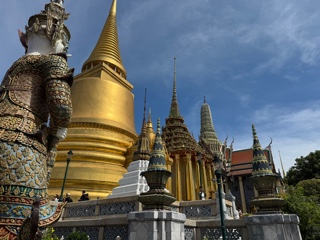 Temples at the Royal Palace, Bangkok 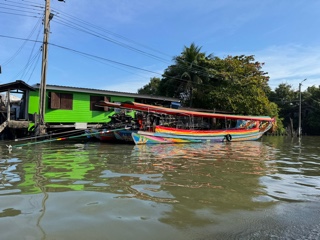 Houses on stilts with the local working ‘long-tail’ boats alongside 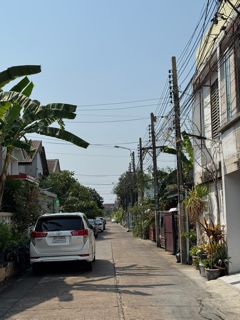 Quieter side streets of terraced housing Pattaya is also becoming more of a high-rise city, having been a fishing village until the 1960’s. It’s popularity started to grow after US troops came here to rest during the Vietnam War. John was able to do some off-road motorcycling here, whilst I did some sightseeing and visited the Spa. It was in Pattaya that we discovered the mobile market stalls. Imagine dining at a roadside table and suddenly a market stall fully laden with dresses hanging on hangers and mannequins pulls up to block your view! The stalls are attached to the side of motor scooters and zip around the city trying to catch that elusive impulse buyer. All manner of goods were available, from teddy bears to chicken legs being barbecued as the scooter drives along! 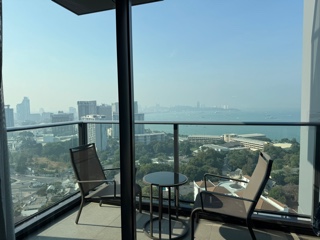 Pattaya bay 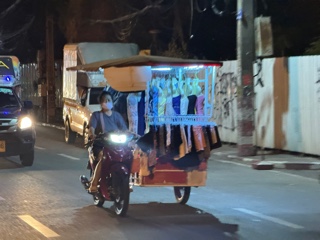 Anyone need a dress? Normally, when visiting foreign countries, I like to learn some of the language and try to work out what the written language says. I found the Thai written language completely impenetrable, and didn’t fare any better with even simple every day spoken phrases. Talking to someone who had lived in Thailand for many years, they said they were able to speak the language but had never mastered writing it so I didn’t feel so bad after that. 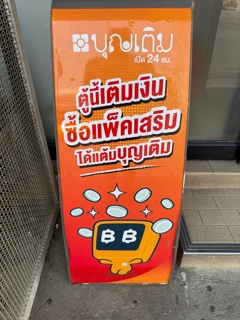 I reckon this is open 24 hours - but goodness knows what it does! The King of Thailand is seen as a semi-divine figure and all over Bangkok there are large pictures of him and his family. From conversations we had it was clear that the King and his way of life are closely scrutinised by the public. Mind you, we were also told there’s a law forbidding anyone to speak ill of the King, with a penalty of 15 years in jail for each anti-royal comment, and people were very careful in what they said. 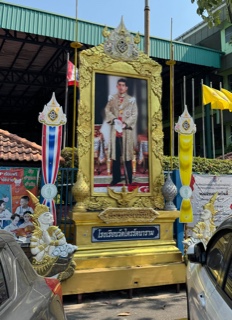 One of many royal portraits in the streets Another common sight in the streets are the Buddhist offerings at the entrances to buildings. These offerings are made to show respect and gratitude, and to give thanks for prayers answered. Many of the offerings were bottles of Strawberry Fanta, with a straw inserted and helpfully pointed towards the Buddha figure. We were told that the colour red symbolises luck and offering a sweet drink will keep the spirits contented so that they will protect, rather than bother, those living or working in the buildings. 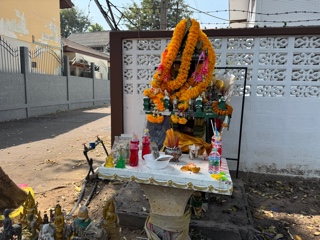 Offerings of Strawberry Fanta A visit to Ayutthaya, 50 miles north of Bangkok, gave us a good insight into the history of this region. Founded in 1350 by a Chinese merchant, Ayutthaya became a major centre of global diplomacy and trade, remaining so until it was destroyed by the Burmese in 1767. After it was burnt to the ground the city was never rebuilt and the Royal Palace precinct and immediate surroundings are now protected as a UNESCO World Heritage archaeological site. Once home to one million people, it is believed that there are many more archaeological remains still buried in the surrounding area. Ayutthaya was our final excursion before we headed to Thailand’s border and our next destination - Cambodia. 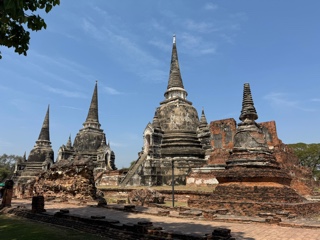 Ayutthaya Royal Palace precinct |